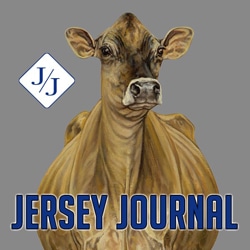Herd Immunity, Vaccines . . . and Cows
Two terms associated with our beautiful bovines are making headlines for their role in COVID-19 recovery — herd immunity and vaccination.
Without taking a stance on if, when or how they will help us beat the pandemic, a brief history of the terms is useful knowledge and a fun way for us to honor cows.
This entertaining (and educational) take on herd immunity and vaccinations, from 13News Now, caught our eye and made us think how cows have contributed to human health for centuries. Though this presentation illustrates the concepts with black and white dairy cows, a.k.a. Holsteins, it would be equally effective with Jerseys. To learn more about Jerseys, the small brown dairy cows that produce the most nutrient-dense milk, visit USJersey.com.
Herd Immunity
What is herd immunity? Is it associated with cows? Herd immunity, also known as community immunity or herd protection, has nothing to do with cows. Rather, it refers to the human population as community, a herd of people of sorts. It occurs when most of the population is immune to an infectious disease. Herd immunity provides indirect protection to those who are not immune to the disease because they are surrounded by people who are immune.
For example, if 80% of a population is immune to a virus, four out of every five people who encounter someone with the disease will not get sick, nor will they further spread the disease. Generally, 70-90% of a population needs to be immune to achieve immunity, depending on the infectiousness of the virus.
As with any other infection, there are two ways to achieve herd immunity for SARS-CoV-2, the virus that causes COVID-19: a large proportion of the population either gets infected or gets a protective vaccine. Though health advisors and leaders have various opinions on dealing with COVID-19, most agree that herd immunity is not a preventative strategy, but rather the end result of an available vaccine.
For one take on achieving herd immunity, read this article from the Bloomberg School of Health at John Hopkins University or this update published on their news center, Hub. Or, read this article from the New York Times or this one from Science Alert.
Vaccines
Though one instantly thinks “cows” with herd immunity, their association with the term vaccine is less obvious, but more direct.
Development of the world’s first safe and reliable vaccine is credited to British doctor Edward Jenner, who demonstrated immunity to smallpox (variola virus) with an inoculation of cowpox (vaccinia virus) in 1796. Rudimentary by today’s standards, he harvested bits of a cowpox lesion from a milkmaid’s hand and scratched it into the arm of an eight-year-old boy. Six weeks later, Jenner variolated the boy’s arm with smallpox. The boy was unaffected by this and subsequent exposures to smallpox.
In an article on his findings, Jenner used the Latin translation of cowpox, variolae vaccinae. The Latin word vaccinae was formed from the adjective vaccinus, meaning “of or relating to cows.” This word, in turn, was based on the noun vacca, meaning “cow.” The cowpox material used for injections was then called vaccine. The injection itself was called vaccination. From this noun we created the verb vaccinate and the noun vaccinator.
For more information on the history of vaccines and immunization, read this article published by Health Affairs or this one by Time.
Learn more about vaccine safety from the Centers for Disease Control and Prevention.
While We Are At It
Let’s also pay tribute to our beautiful bovines for the other roles they play in improving human health.
When dairy cattle are sold for beef purposes, their value continues far beyond milk production. By using the entire beef animal from nose to tail, more than 100 individual drugs can be created. These products include insulin for diabetes and materials for allergy medicines vaccines, vitamins, burn ointments, first aid creams, respiratory inhalers, anti-rejection drugs, bandages and other laboratory research materials.
Read more about the role cattle play in medicines for human health, read this article published by Beef magazine.




